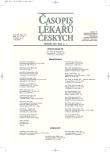Effect of Hypolipidemic Treatment on the Composition of Bile and the Risk or Cholesterol Gallstone Disease
Vliv hypolipidemické léčby na složení žluče a riziko cholesterolové cholelitiázy
Obezita, diabetes mellitus 2. typu a dyslipidémie, charakterizovaná hypertriglyceridémií a poklesem HDL-cholesterolu, jsou rizikovými faktory cholesterolové cholelitiázy. Společným jmenovatelem těchto stavů je inzulínová rezistence. V patogenezi cholelitiázy se uplatňují tři základní mechanizmy – hypersaturace žluči cholesterolem, poruchy nukleace cholesterolu a dysmotilita žlučových cest. Základním etiopatogenetickým faktorem cholesterolové cholelitiázy je solubilizace cholesterolu solemi žlučových kyselin a lecitinem. V závislosti na jejich vzájemném poměru se ve žluči tvoří jednoduché nebo smíšené micely a nestabilní unilamelární nebo multilamelární vezikuly. Hypersaturace žluče cholesterolem a jeho vypadávání z multilamelárních vezikul iniciuje vznik cholesterolové cholelitiázy. Hypolipidemická léčba významně ovlivňuje lipidové složení žluče i další etiopatogenetické mechanizmy cholelitiázy. Syntéza žlučových lipidů i jejich sekrece do žluče je velmi těsně koordinována a regulována. Pool neesterifikovaného cholesterolu je zdrojem pro sestavení VLDL a spolu s HDL-cholesterolem také zdrojem pro jeho sekreci do žluče. Hlavní metabolický produkt degradace cholesterolu představují žlučové kyseliny, syntetizované zejména z LDL-cholesterolu. Rychlost syntézy žlučových kyselin je řízena hlavně 7α-hydroxylázou cholesterolu (Cyp7A1). Léčba dyslipidémie niacinem a pryskyřicemi neovlivňuje saturaci žluči cholesterolem ani incidenci cholelitiázy. Účinky ezetimibu ve vztahu k cholesterolové cholelitiáze zatím nebyly u lidí publikovány. Léčba fibráty je spojována se zvýšenou saturací žluče cholesterolem v důsledku inhibice aktivity Cyp7A1, zvýšení toku cholesterolu cestou HDL a jeho sekrece do žluči. V klinických studiích podávání fibrátů zvyšovalo koncentrace cholesterolu ve žluči a snižovalo koncentrace žlučových kyselin. Důsledkem byl vzestup saturačních indexů pro cholesterol i výskyt cholelitiázy. Léčba statiny k cholesterolové litiáze nevede. Podávání pravastatinu a simvastatinu snižovalo saturační cholesterolové indexy. U osob s endogenní hypertriglyceridémií a poklesem HDL-C bylo podávání vícenenasycených mastných kyselin řady n-3 (PUFA n-3) spojeno s poklesem koncentrace cholesterolu ve žluči, jiné práce popsaly příznivé ovlivnění nukleizačního času, úpravu reaktivity žlučových cest na cholecystokinin a prevenci rozvoje cholelitiázy způsobené rychlým poklesem tělesné hmotnosti.
Klíčová slova:
cholesterolová cholelitiáza, dyslipidémie, sekrece žlučových lipidů, saturace žluči cholesterolem, riziko cholelitiázy, hypolipidemická léčba.
Authors:
A. Žák; M. Zeman; K. Hrubant; M. Vecka; E. Tvrzická
Authors‘ workplace:
IV. interní klinika 1. LF UK a VFN, Praha
Published in:
Čas. Lék. čes. 2007; 146: 24-34
Category:
Review Article
Overview
Obesity, diabetes mellitus type 2 and dyslipidemia, characterized by hypertriglyceridemia and low HDL-cholesterol levels, are risk factors for cholesterol gallstone disease. The common denominator of above-mentioned states is insulin resistance. Hypolipidemic treatment significantly influences not only the biliary lipid composition, but also other etiopathogenetic mechanisms of the disease. Three principal defects are involved in gallstone formation – cholesterol supersaturation, accelerated nucleation, and gallbladder dysmotility. The degree of cholesterol saturation in gallbladder bile is the most important predictor of cholesterol crystal formation. Cholesterol, lecithin and bile acids are the major components in bile. According to the molar ratios of the three main components, simple or mixed micelles, unstable unilamellar or multilamellar vesicles are formed in the bile. The cholesterol supersaturation of the gallbladder bile and cholesterol crystal formation from the unstable multilamellar vesicles initiates the onset of cholesterol cholelithiasis. The pool of unesterified cholesterol is the source for VLDL synthesis; together with HDL-cholesterol, it is also the source for cholesterol secretion into the bile. The main metabolic products of cholesterol degradation are bile acids, which are synthesized predominantly from LDL-cholesterol. The rate of the production of primary bile acids is principally regulated by cholesterol 7α-hydroxylase (CYP7A1). The treatment of dyslipidemia with niacin and resins does not influence the saturation of bile with cholesterol or the incidence of cholelithiasis. The effects of ezetimibe in human patients with the respect of cholesterol cholelithiasis have not been published. The fibrate treatment is associated with increased cholesterol saturation of bile due to inhibition of CYP7A1 activity, enhanced flux of cholesterol via HDL and increased secretion of cholesterol into bile. The clinical studies describe cholesterol supersaturation in bile and increased frequency of cholelithiasis as well. The administration of pravastatin and simvastatin led to reduced cholesterol saturation indexes. The patients with endogenous hypertriglyceridemia and low HDL-cholesterol being administered with polyunsaturated fatty acids of n-3 family had decreased cholesterol concentration in bile. Other authors described beneficial effect of fish oil on the biliary cholesterol nucleation time, improvement of gallbladder sensitivity to cholecystokinin and the prevention of cholesterol gallstone formations caused by rapid weight loss.
Key word:
cholesterol cholelithiasis, dyslipidemia, secretion of bile lipids, bile saturation with cholesterol, risk of cholelithiasis, hypolipidemic treatment.
Labels
Addictology Allergology and clinical immunology Angiology Audiology Clinical biochemistry Dermatology & STDs Paediatric gastroenterology Paediatric surgery Paediatric cardiology Paediatric neurology Paediatric ENT Paediatric psychiatry Paediatric rheumatology Diabetology Pharmacy Vascular surgery Pain management Dental HygienistArticle was published in
Journal of Czech Physicians

- Metamizole at a Glance and in Practice – Effective Non-Opioid Analgesic for All Ages
- What Effect Can Be Expected from Limosilactobacillus reuteri in Mucositis and Peri-Implantitis?
- Advances in the Treatment of Myasthenia Gravis on the Horizon
- Metamizole vs. Tramadol in Postoperative Analgesia
- Possibilities of Using Metamizole in the Treatment of Acute Primary Headaches
Most read in this issue
- Lower Dyspeptic Syndrome Recommended Diagnostic and Therapeutic Practice for General Practitioners 2006
- HIV/AIDS and Pathology in Blood Count
- Incidence of Hiatal Hernias in the Current Endoscopic Praxis
- Postoperative Pulmonary Thromboembolism and Nosocomial Pneumonias: Differential Diagnosis
